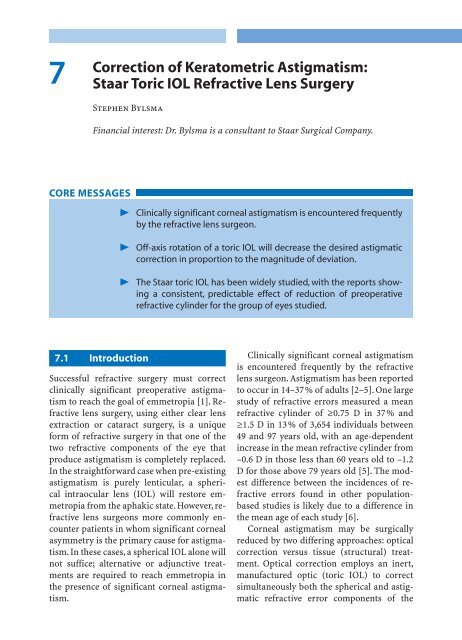Refractive Lens Surgery
Refractive Lens Surgery
Refractive Lens Surgery
Create successful ePaper yourself
Turn your PDF publications into a flip-book with our unique Google optimized e-Paper software.
7<br />
Correction of Keratometric Astigmatism:<br />
Staar Toric IOL <strong>Refractive</strong> <strong>Lens</strong> <strong>Surgery</strong><br />
Stephen Bylsma<br />
Financial interest: Dr. Bylsma is a consultant to Staar Surgical Company.<br />
CORE MESSAGES<br />
2 Clinically significant corneal astigmatism is encountered frequently<br />
by the refractive lens surgeon.<br />
7.1 Introduction<br />
2 Off-axis rotation of a toric IOL will decrease the desired astigmatic<br />
correction in proportion to the magnitude of deviation.<br />
2 The Staar toric IOL has been widely studied, with the reports showing<br />
a consistent, predictable effect of reduction of preoperative<br />
refractive cylinder for the group of eyes studied.<br />
Successful refractive surgery must correct<br />
clinically significant preoperative astigmatism<br />
to reach the goal of emmetropia [1]. <strong>Refractive</strong><br />
lens surgery, using either clear lens<br />
extraction or cataract surgery, is a unique<br />
form of refractive surgery in that one of the<br />
two refractive components of the eye that<br />
produce astigmatism is completely replaced.<br />
In the straightforward case when pre-existing<br />
astigmatism is purely lenticular, a spherical<br />
intraocular lens (IOL) will restore emmetropia<br />
from the aphakic state. However, refractive<br />
lens surgeons more commonly encounter<br />
patients in whom significant corneal<br />
asymmetry is the primary cause for astigmatism.<br />
In these cases, a spherical IOL alone will<br />
not suffice; alternative or adjunctive treatments<br />
are required to reach emmetropia in<br />
the presence of significant corneal astigmatism.<br />
Clinically significant corneal astigmatism<br />
is encountered frequently by the refractive<br />
lens surgeon. Astigmatism has been reported<br />
to occur in 14–37% of adults [2–5]. One large<br />
study of refractive errors measured a mean<br />
refractive cylinder of ≥0.75 D in 37% and<br />
≥1.5 D in 13% of 3,654 individuals between<br />
49 and 97 years old, with an age-dependent<br />
increase in the mean refractive cylinder from<br />
–0.6 D in those less than 60 years old to –1.2<br />
D for those above 79 years old [5]. The modest<br />
difference between the incidences of refractive<br />
errors found in other populationbased<br />
studies is likely due to a difference in<br />
the mean age of each study [6].<br />
Corneal astigmatism may be surgically<br />
reduced by two differing approaches: optical<br />
correction versus tissue (structural) treatment.<br />
Optical correction employs an inert,<br />
manufactured optic (toric IOL) to correct<br />
simultaneously both the spherical and astigmatic<br />
refractive error components of the



